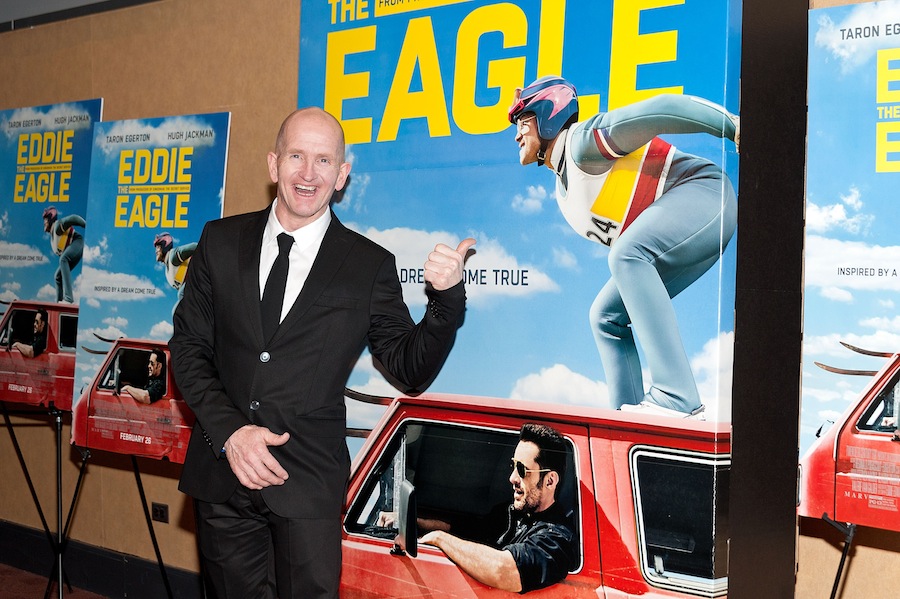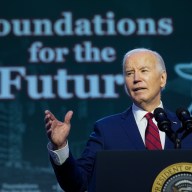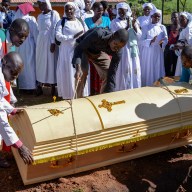Eddie Edwards, aka Eddie the Eagle, is very nice. That’s to be expected: In 1988, at the age of 24, the southern Englishman became a sudden celebrity when he came in last in ski jumping at the Olympics in Calgary, Canada. It wasn’t that he lost that made him famous; it was his uncontainable enthusiasm when he finished a jump — and that he had only been ski jumping for 20 months. “Everyone else had been jumping for 20 years! There was no way I was going to beat those people,” he tells us. “For me, getting to the Olympic games was my gold medal. I knew I was going to come in last.” RELATED: Review: “Eddie the Eagle” is a deceptively simple inspirational sports movie His inspirational and stranger-than-fiction tale is now, perhaps inevitably, a movie. “Eddie the Eagle” stars Taron Egerton (the boyish lead of “Kingsman,” here even more affably eccentric) as Edwards in a story he admits is heavily fictionalized. The surly coach played by Hugh Jackman: He’s an amalgamation. The injuries: They’re real. “It’s not factually correct. But then it wouldn’t be a movie; it would be a documentary. But what they’ve done is capture the heart and essence of my story,” he says. “I loved it. I needed a box of Kleenex after I watched it.” RELATED: Interview: Adrien Brody talks “Backtrack” and becoming a painter Edwards chronicled his tall tale exploits in the 1999 book “On the Piste.” Since then he’s fielded movie offers; people like James McAvoy and Martin Freeman have at some point been considered to play him. He says he’s seen 16 scripts over the years, not all of them ideal. “The worst ones were from Steve Coogan. They were just him doing Alan Partridge,” he admits, referring to the comic’s most famous character: an oblivious and venal entertainment personality. His version took a more savage take on the Edwards story. “Even the dialogue is what you’d expect Alan Partridge to say. I didn’t like that.” One thing “Eddie the Eagle” only slightly touches on is the swarm of press that engulfed him. In the four or five days between his last jump on the 90-meter slope — which he at least survived — and the closing ceremonies, he was flown out to Los Angeles to go on Johnny Carson. “I thought everyone was getting the same attention. It was the Olympics. There were a thousand athletes there,” he remembers. “It wasn’t until I got home that it hit me. I had 30 policemen meet me at the airport, to help me get through it. I had no idea what they were on about. Two weeks before, nobody knew me. Then I couldn’t walk down to the local news agent to buy a paper without being stopped and mobbed.” RELATED: Who we hope will win the big categories at the Oscars He says his feet barely touched the ground in the three years after. He never made it into the Olympics again, despite trying — and in part because his stunt instigated the “Eddie the Eagle Rule,” which tightened the parameters of eligibility. Still, he was a torchbearer at the 2010 Olympics in Vancouver and has found success on television, radio and at motivational speaking. Edwards says one reason his story has lasted is that it redefines how we think about winning. “To some, success is making a million quid or winning a gold medal. For others it could be simple things, like getting out of bed in the morning, going to work, getting a paycheck,” he says. “Success comes in many different forms. For me success was getting to the Olympic games. Yes, I came in 58th. But it didn’t matter. My success was getting there. The fact that you get off your bum means you’re a success.” RELATED: Interview: Michelle Yeoh talks about the sequel to “Crouching Tiger, Hidden Dragon” Edwards says he’s never quit his day job: plastering. He’s still doing it, at least in between talking to strangers.
“I love it. It keeps me grounded, it keeps me fit, it keeps me active,” he explains. His other work can be very fickle; he’ll be busy for a few months, then have nothing to do. “I just go back to my building, my plastering. I’m quite happy. I love doing that and doing the PR. I’ll always do it. I might not have to do much plastering for the rest of this year. But if I’ve got a month off, I’ll get my tool and plaster someone’s ceiling or wall. Because I enjoy doing it.” Follow Matt Prigge on Twitter @mattprigge
The real life Eddie the Eagle talks about loving the movie about him

Getty Images


















